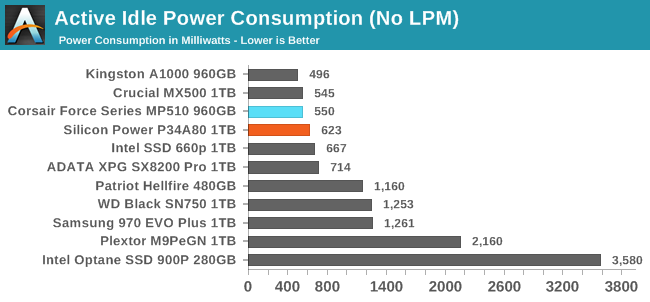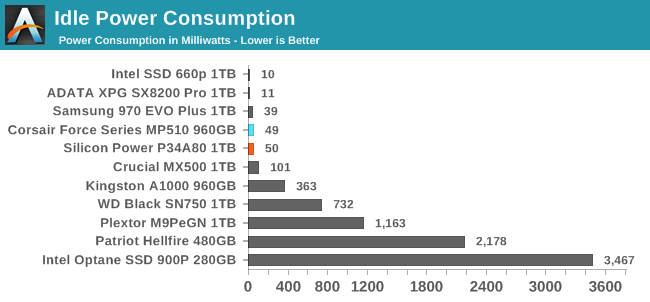The Silicon Power P34A80 SSD Review: Phison E12 With Newer Firmware
by Billy Tallis on February 28, 2019 10:00 AM EST- Posted in
- SSDs
- Storage
- Toshiba
- Phison
- Silicon Power
- M.2
- NVMe
- 3D TLC
- PS5012-E12
Power Management Features
Real-world client storage workloads leave SSDs idle most of the time, so the active power measurements presented earlier in this review only account for a small part of what determines a drive's suitability for battery-powered use. Especially under light use, the power efficiency of a SSD is determined mostly be how well it can save power when idle.
For many NVMe SSDs, the closely related matter of thermal management can also be important. M.2 SSDs can concentrate a lot of power in a very small space. They may also be used in locations with high ambient temperatures and poor cooling, such as tucked under a GPU on a desktop motherboard, or in a poorly-ventilated notebook.
| Silicon Power P34A80 NVMe Power and Thermal Management Features |
|||
| Controller | Phison PS5012-E12 | ||
| Firmware | ECFM12.1 | ||
| NVMe Version |
Feature | Status | |
| 1.0 | Number of operational (active) power states | 3 | |
| 1.1 | Number of non-operational (idle) power states | 2 | |
| Autonomous Power State Transition (APST) | Supported | ||
| 1.2 | Warning Temperature | 70 °C | |
| Critical Temperature | 90 °C | ||
| 1.3 | Host Controlled Thermal Management | Supported | |
| Non-Operational Power State Permissive Mode | Not Supported | ||
The supported power features on the Silicon Power P34A80 are the same as on the earlier 11.0 firmware. The maximum power figures for the active power states are the same relatively high limits found on the Corsair Force MP510, rather than the lower values seen on our earlier reference design engineering sample from Phison.
| Silicon Power P34A80 NVMe Power States |
|||||
| Controller | Phison PS5012-E12 | ||||
| Firmware | ECFM12.1 | ||||
| Power State |
Maximum Power |
Active/Idle | Entry Latency |
Exit Latency |
|
| PS 0 | 10.73 W | Active | - | - | |
| PS 1 | 7.69 W | Active | - | - | |
| PS 2 | 6.18 W | Active | - | - | |
| PS 3 | 49 mW | Idle | 2 ms | 2 ms | |
| PS 4 | 1.8 mW | Idle | 25 ms | 25 ms | |
Note that the above tables reflect only the information provided by the drive to the OS. The power and latency numbers are often very conservative estimates, but they are what the OS uses to determine which idle states to use and how long to wait before dropping to a deeper idle state.
Idle Power Measurement
SATA SSDs are tested with SATA link power management disabled to measure their active idle power draw, and with it enabled for the deeper idle power consumption score and the idle wake-up latency test. Our testbed, like any ordinary desktop system, cannot trigger the deepest DevSleep idle state.
Idle power management for NVMe SSDs is far more complicated than for SATA SSDs. NVMe SSDs can support several different idle power states, and through the Autonomous Power State Transition (APST) feature the operating system can set a drive's policy for when to drop down to a lower power state. There is typically a tradeoff in that lower-power states take longer to enter and wake up from, so the choice about what power states to use may differ for desktop and notebooks.
We report two idle power measurements. Active idle is representative of a typical desktop, where none of the advanced PCIe link or NVMe power saving features are enabled and the drive is immediately ready to process new commands. The idle power consumption metric is measured with PCIe Active State Power Management L1.2 state enabled and NVMe APST enabled if supported.


The P34A80 has slightly higher active idle power consumption than the Corsair MP510, but still lower than any high-end NVMe drive using a competing controller. The idle power consumption is unchanged, leaving the Phison E12 with good power management but not quite the best achievable on our desktop testbed.

The P34A80 is slightly slower to wake up from idle than the Corsair MP510, but at under 3ms it's still plenty fast, and otherwise is only really beat by drives that are unable to reach a deep idle state on our desktop testbed.










10 Comments
View All Comments
stanleyipkiss - Thursday, February 28, 2019 - link
5 year warranty is pretty good for the price.XabanakFanatik - Friday, March 1, 2019 - link
Where did these mysterious benchmark results in the charts for the 970 PRO 1TB come from? There still hasn't been a review posted for it.IndianaKrom - Sunday, March 3, 2019 - link
I noticed that as well, and I actually have a 970 Pro / 1 TB. I got it a couple months before the 970 EVO Plus was announced and was kind of kicking myself for spending more on it figuring the EVO Plus was probably the same or better performance for less, but turns out the Pro still reigns supreme in everything but burst writes.Luckz - Wednesday, December 4, 2019 - link
Note that those are now likely made with E12S instead of E12, half the DRAM, and 96L instead of 64L flash, so performance will vary and be worse in some use cases than what is reviewed here.schevux - Monday, January 6, 2020 - link
Hey what do you mean by that ? How much the performance would change ? I am considering this over 970 evo by these benchmarks but if the performance would be worse i would go with 970 evo. Thanks.msroadkill612 - Monday, May 18, 2020 - link
Ta for the heads up. am now leery of SP. that stuff is not cricket (kosher).quakerj - Saturday, January 11, 2020 - link
I would get the 970 Evo. I ordered a 1TB P34A80 and received it today. It is nothing like what has been reviewed here. Flash chips have the marking "Unic2 UNN1TTE1B1JEA1." I think that's Chinese flash, Google isn't very helpful other than providing a link to Unic2 flash manufacturer, a Chinese website. Additionally my card contains Nanya DDR3 DRAM modules, not DDR4 like the reviewed model. Seems like a classic bait and switch. It's getting sent back to Amazon in a fast second, I would avoid like the plague.msroadkill612 - Monday, May 18, 2020 - link
I misposted this -Ta for the heads up. am now leery of SP. that stuff is not cricket (kosher).
i cant see why a noname cant do a decent e12 product, but not this thanks.
quakerj - Saturday, January 11, 2020 - link
For what it's worth, a major redesign warrants a new model number or revision suffix. If you go and buy this, it's not going to perform like the reviewed model, there are simply too many changes. It'll be a fast SSD no doubt, but I think SP pulled a fast one here and should be more transparent about the changes. They still advertise all these [original card] reviews on their website as though you're going to receive the same product. Just my humble opinion...Mueller - Wednesday, April 22, 2020 - link
This is really an excellent read for me, Have to admit that you really are one of the greatest bloggers I ever saw. This platform is really useful for those who interested in technology. I prefer to play blackjack on https://interactivecasinos.org/casino-games/blackj... In this case, the most important thing is to choose a reliable bookmaker on the site Read reviews on the best!